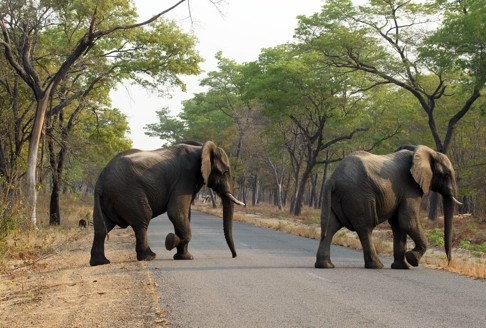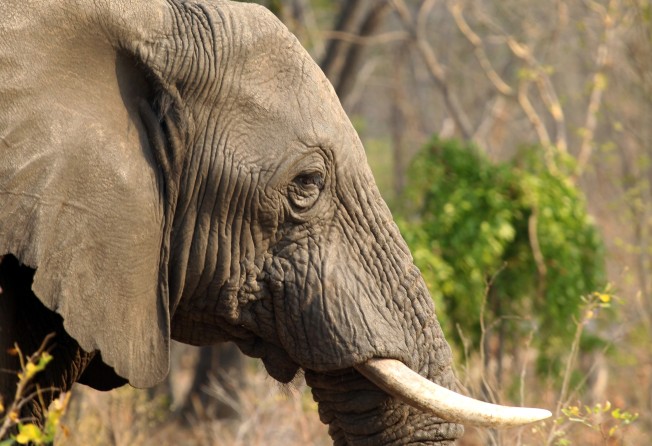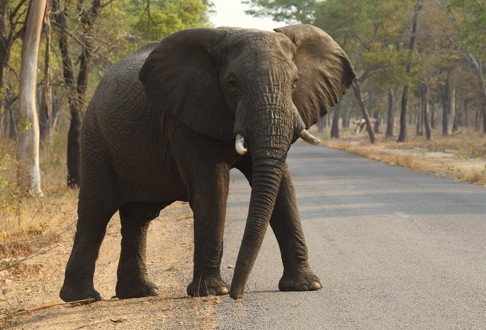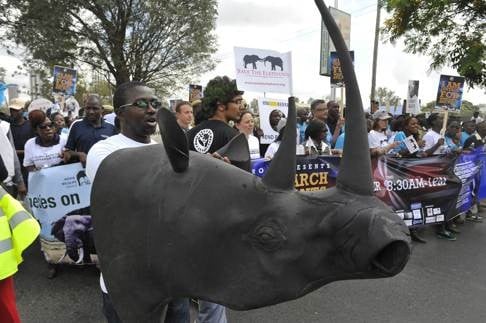
Death by cyanide: poachers kill 40 elephants in Zimbabwe as China drives ivory demand
Spate of deaths comes as conservationists report that a well-known elephant in South Africa is feared to have been killed in recent days

The elephant died in agony. When they found his body, his eyes were closed, and a stream of blood trickled from his trunk.
He was a middle-aged male, one of 40 elephants poisoned in Zimbabwe in recent weeks.
“I get choked up, even as I speak,” said Debbie Ottman, of the Kariba Animal Welfare Fund Trust in Zimbabwe. She was one of the animal welfare activists who found the carcasses of three elephants near the town of Kariba in northern Zimbabwe late last month; the pachyderms later tested positive for cyanide poisoning. “It makes me very angry and very emotional.”
The killer baited oranges with cyanide, which is used in illegal gold mining and which was found in the gut of the male elephant.

Tanzania’s elephant population plummeted by 60 per cent to 43,330 in the five years ending in 2014, according to the Great Elephant Census, carried out by a coalition of wildlife groups. Mozambique lost half its elephants in the same period, falling to 10,300.
The statistics underscore the toxic mix of determined criminal gangs, corrupt government officials and a strong market for smuggled ivory in Asia — particularly in China, which has deepened its economic ties to Africa in recent years.
News of the spate of Zimbabwe cyanide poisonings, blamed on poachers, comes as conservationists report that a well-known elephant from South Africa’s Kruger National Park, one of the park’s biggest tuskers, is feared to have been killed by hunters in recent days after wandering across the border into Zimbabwe.
South African wildlife group, the Conservation Action Trust, said a huge bull elephant killed by hunters in Zimbabwe was probably Nkombo, who was collared some years ago in Kruger National Park but lost his collar last year. The trust said hunting websites were abuzz with excitement about the killing of the animal with 55kg tusks, adding it was probably the biggest bull killed since 1986.

In Zimbabwe’s current desperately dry and harsh conditions, the poachers placed salt laced with cyanide near wildlife watering holes, killing not only the elephants but other animals too, including predators feeding off the pachyderms’ carcasses.
Zimbabwe’s economic crisis has exacerbated the poaching spree, as criminal gangs move in, luring the rangers who are supposed to protect the animals into either offering information or even killing the animals. Authorities recently arrested several wildlife officials for involvement in poaching of elephants. Five men questioned over the cyanide poisoning in Hwange National Park were all living in staff quarters at the park base camp.
Dave Dell, of Friends of Hwange, which raises donations to run pumps for about 80 watering holes in Hwange National Park, said cyanide poisoning was again increasing, after an incident two years ago in which up to 300 elephants were poisoned.
“The authorities are doing their best. We are doing our best to clamp down on it. But the situation in this country is so desperate that people will go and do something stupid for US$100,” he said.
“These animals have got feelings and emotions. It’s not really about numbers,” he added.

“Usually they don’t get more than 100 metres” after taking the poison, he added. “The suffering is horrible. They get weak very quickly and collapse. You might not die quickly, but you don’t walk very far.”
The elephants poisoned near Kariba all had their tusks, so authorities believe a poaching attempt was botched or interrupted.
The older bull elephants are most prized by poachers, and hunters, because of their enormous tusks. But they play an important social role, socialising young bulls in acceptable herd behaviour.
However, the cyanide poisoning is indiscriminate and often kills mothers and calves with no tusks.
Tom Milliken, director of Traffic for Southern Africa based in Harare, Zimbabwe, said criminals seemed to be using cyanide because it was readily available and stealthier than high-powered rifles.
“Most ivory from Africa makes its way to Asia, and within Asia, China’s middle class seems to have an insatiable appetite for ivory right now and we are paying the consequences here in Africa.”
Tanzania last week arrested a Chinese businesswoman, Yang Fenglan, 66, also known as the “Queen of Ivory,” accused of involvement in millions of dollars in ivory deals. Yang has been in Tanzania since the 1970s, when she arrived as an interpreter on a Chinese rail project.
In May, Mozambican authorities seized 340 tusks, or 2,650 pounds of ivory, and 65 rhino horns. Two Chinese nationals were arrested, one of whom is also accused of offering police a US$34,000 bribe to drop the charges.
Milliken said Chinese authorities were beginning to take tougher action against their citizens caught smuggling elephant tusks or rhino horn, but more needed to be done.
“The real gap in their law enforcement is they need a focus here in Africa,” he said.